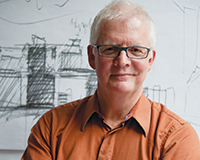 First thing on the Monday after Brexit was announced, I presented to the studio (and a few clients who snuck in at the back) my thoughts. Yes, we were shocked, and some of us were sad, but the time for sulking was over. It was time to roll up our sleeves and get on with the business of architecture.
First thing on the Monday after Brexit was announced, I presented to the studio (and a few clients who snuck in at the back) my thoughts. Yes, we were shocked, and some of us were sad, but the time for sulking was over. It was time to roll up our sleeves and get on with the business of architecture.
Now, with a new prime minister, a new cabinet, and a new political future for the UK, the time is ripe to set, and indeed change, the political agenda with regard to the built environment. If I ever get the opportunity to bend an ear, here are the points I would try to raise:
- Make a decision on airport expansion. Nothing will say “Britain means business” more loudly post-Brexit than finally committing on a new airport for the country. We’ve rumbled along in the background for what feels like a decade; surely now is the time to put pen to paper and decide the location, the size and the timetable. This will help to position our future in the global economy.
- Agree some sustainability targets and explain how you expect people to achieve them. Ideally all buildings would be so good as to meet the ratings for high sustainability, but the fact is that doesn’t always happen. Targets can help the industry to avoid complacency and ensure we keep pushing the boundaries. With the Department of Climate Change swallowed up by the newly formed Department for Business, Energy & Industrial Strategy, it would be great to know that leading the sustainability agenda remains a priority for the UK.
- Talk about the quality of housebuilding. Every prime minister talks about prioritising housebuilding; a conversation about quality is what would really stand apart. If only a third of the biggest housebuilders employ in-house architects, what does that say about their concern for and investment in design and placemaking? Momentum is growing to improve the standard. Last year the House of Lords held a select committee that examined how design could be prioritised in our built environment, and recently the All-Party Parliamentary Group for Excellence in the Built Environment called for a new homes ombudsman to drive up housebuilding quality. What better way to set out your stall than with a direct push to raise standards in people’s own bricks and mortar?
- Keep connectivity and infrastructure at the heart of planning. Our latest Future Spaces Foundation research shows how connectivity has the ability to shape communities and positively benefit local economies. Whether it’s major infrastructure projects such as HS2 – which has transformed Birmingham’s fortunes – or incentives for councils to invest more in improving their cycling networks, a focus on connectivity helps make our towns and cities places people want to live and work. Crossrail 2 and HS3 should also be high on the agenda.
- Explore how we can use this opportunity to make the country work for everyone. How will we bring opportunities to those outside London? If we are really to spread the economic wealth around the country, it means ensuring that other towns and cities can be prosperous. So does that entail further devolution around the UK? Looking at densification of other towns and cities? Investing in garden cities? Improving infrastructure and connectivity across the country? Each of these options has the built environment at its heart and should require our industry specialists at the table.
In the words of Andy Murray, “I certainly wouldn’t like to be prime minister,” but I do appreciate Theresa May’s vision of “making the country work for everyone.” In my mind, the built environment – the places and spaces where we live, work, travel and relax – provides the infrastructure and the facilities for virtually everything. So I would say to the cabinet, just like I did to the studio, we’re rolling up our sleeves and getting on with it. The points above will just help us do it all that little bit better.
Ken Shuttleworth is the founder of Make Architects










